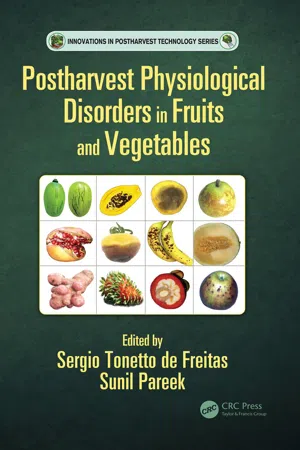
Postharvest Physiological Disorders in Fruits and Vegetables
- 824 pages
- English
- ePUB (mobile friendly)
- Available on iOS & Android
Postharvest Physiological Disorders in Fruits and Vegetables
About This Book
This book, chock full of color illustrations, addresses the main postharvest physiological disorders studied in fruits and vegetables. For a wide variety of fruits and vegetables, Postharvest Physiological Disorders in Fruits and Vegetables describes visual symptoms, triggering and inhibiting mechanisms, and approaches to predict and control these disorders after harvest. Color photographs illustrate the disorders, important factors, physiology, and management. The book includes a detailed description of the visual symptoms, triggering and inhibiting mechanisms, and possible approaches to predict and control physiological disorders. The mechanisms triggering and inhibiting the disorders are discussed in detail in each chapter, based on recent studies, which can help readers better understand the factors regulating each disorder. The description of possible approaches to predict and control each disorder can help growers, shippers, wholesalers, and retailers to determine the best management practices to reduce disorder incidence and crop losses.
Features:
-
- Presents visual symptoms of postharvest physiological disorders that will help readers to precisely identify the disorders in fruits and vegetables
-
- Details mechanisms triggering and inhibiting the postharvest disorders
-
- Explains possible approaches to predict and control these disorders
-
- Suggests the best postharvest management approaches for each crop
Although there are many scientific publications on postharvest physiological disorders, there are no recent reviews or books putting together the most recent information about the mechanisms regulating, as well as about the possible approaches to predict and control these disorders.
Frequently asked questions
Information
ASHRAE | American Society of Heating, Refrigerating and Air-Conditioning Engineers. |
CO2 | Carbon dioxide |
HCOOH (HCO2H) | Formic acid |
K+ | Potassium |
NH3 | Ammonia |
O2 | Oxygen |
R717 | A type of refrigeration equipment fueled by ammonia gas |
Commercial Banana Bunch Management Practices
| Bunch Management Practice | Effect on Physiological Disorders |
| Proper fertilization practices (e.g., K + ) | Reduced incidence of sinkers and yellow pulp |
| Leaf removal. Remove leaves that rub against bunches. | Reduced incidence of alligator skin and leaf rubbing injury |
| Detrashing. Remove leaves having greater than 50% of leaf area covered by black or yellow Sigatoka. | Reduced incidence of precocious ripening |
| Bunch covers. Use perforated polyethylene sleeves to cover bunches. Tie the open ends closed at the top and bottom of the bunch. | Reduced incidence of sooty mold, sunscald leaf rubbing injury, and insect damage |
| Deflowering. Pluck female flowers from fingers twice per week before bagging with polyethylene sleeves, while the flowers are fresh (not dried). | Reduced incidence of sap stains (if not plucked when fresh, the dry flowers must be removed at the packinghouse, which starts sap flow and causes sap stain of fingers |
| Bunch sprays. Spray bunches with a fungicide before bagging. | Reduced incidence and severity of sooty mold, sooty blotch, and other fungal diseases |
| Avoid jarring pseudostems. Do not bump into pseudostems during field operations or at harvest. | Reduced incidence of formic acid injury to bunches and fruits caused by certain species of ants |
| Bag and tag the bunches. After plucking the female flowers, spray the bunch, cut off the male flower (the “bell”), bag the bunch, and tag with colored ribbons. This ensures that bunches of identical ages are harvested on the same date. | Reduced incidence of sooty mold, fruit abrasion injury and bunches of mixed ripeness |
| Gentle handling. Handle bunches with care during harvest and transport to the packing facility. | Reduced incidence of bruising |
| Rogue mutant plants. Remove plants with somaclonal variations produced during tissue culture. | Reduced incidence of somaclonal variation, mutant phenotypes and fruit abnormalities |
| Crop logging. Use an accepted crop logging and leaf sampling protocol for banana leaf tissue in your area1. Tissue analysis can help offset nutrient deficiencies (Table 16.2). | Reduced incidence of sinkers and yellow pulp |
Recommended Levels of Elements in Banana Leaf Tissue in Hawaii (Silva & Uchida, 2000)
| Element | Symbol | Range (suggested) |
| Nitrogen | N | 2.8 – 3.1% |
| Phosphorous | P | 0.18 – 0.20% |
| Potassium | K | 3.2 – 3.5% |
| Calcium | Ca | 0.6 – 1.0% |
| Magnesium | Mg | 0.3 – 0.6% |
| Sulfur | S | 0.22 – 0.25% |
| Iron | Fe | 50 – 100 ppm |
| Manganese | Mn | 30 – 100 ppm |
| Copper | Cu | 10 – 15 ppm |
| Zinc | Zn | 25 – 40 ppm |
| Boron | B | 15 – 25 ppm |
Best practices for banana harvesting and at packinghouses and their effects on various physiological disorders
| Harvest or packinghouse practice | Effect on physiological disorders |
| Gentle handling of bunc... |
Table of contents
- Cover
- Half-Title
- Title
- Copyright
- Dedication
- Contents
- Foreword
- Preface
- Acknowledgements
- Editors
- Contributors
- Section I General Issues, Physiological and Technological Effects
- Section II Temperate Fruits
- Section III Tropical and Sub-Tropical Fruits
- Section IV Vegetables and Tubers
- Section V Processed Fruits and Vegetables
- Section VI Final Considerations
- Index